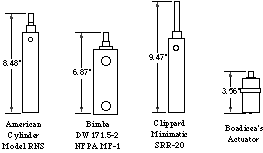
References: [American Cylinder 90], [Bimba 92], [Clippard 92]
Boadicea achieves its greatest improvement in mechanical performance by using pneumatic actuators instead of electric motors. Fluid power has several advantages over electric motors in a robotic application [Nair, et al 83]. Larger walking robots have generally been hydraulically powered [Waldron, et al 84], [Liston and Mosher 68]. For a small robot, however, I believe pneumatics are the proper choice.
Fluid actuators, either hydraulic or pneumatic, are well suited to walking robots because they are high force, low speed actuators. They provide much higher force densities than electric systems. Furthermore, force control is much easier with fluid systems than for electric motors.
Electric motors are inherently high-speed, low-torque actuators. Robotic applications, however, involve relatively low-speed, high torque motions. One solution to this problem is to use high torque (often brushless) motors. These motors are expensive, heavy, and require large electrical currents. A more common solution is to use DC gearmotors, which make force control difficult and are substantially heavier. In fluid power systems the intrinsic transmission ratio is appropriate for robotics applications. Furthermore, the transmission ratio can be altered by changing the area of the actuator pistons, which does not affect actuator weight significantly.
The critical factor in selecting an actuator for a walking robot, or a manipulator, is the torque (or force) density [Angle 91]. The actuator weight determines the overall robot weight, which establishes the torque requirements. With small DC gearmotors, it is difficult to find a motor-gearbox combination with acceptable performance because of the high gear ratio required and the limited strength of the gear teeth. Experience with the six legged robot, Attila, indicates that the torque to weight ratio of commercial gearboxes is insufficient for a high performance legged robot [Angle 91] [Binnard 92].
Hydraulic and pneumatic systems have been compared many times. For a small walking robot, most of the trade-offs favor pneumatics. Pneumatic systems weigh less, and leakage is less of a concern. Compressibility is not necessarily a liability, and most importantly, a pneumatic system allows easy energy storage.
The most significant difference between hydraulic and pneumatic systems is compressibility, which is usually deemed a disadvantage. For a robot, however, compressibility is not necessarily a liability. Several researchers have looked at the advantages of incorporating springs in legged robots [Full, et al 89] [Cavagna, et al 77] [Alexander 90]. A pneumatic actuation system provides these springs "for free." Furthermore, the stiffness, or impedance, of the pneumatic springs can be controlled more easily than with mechanical springs.
Another advantage of a pneumatic system is that the mechanical energy for the robot can be stored as compressed air at a high pressure. A regulator can expand the stored air to the proper working pressure. Structural Composites, Inc., located in Pomona, CA, manufactured a high pressure composite pressure vessel for the Lawrence Livermore National Laboratory [Whitehead 95]. This vessel weighed 1.4 lb, had a rated pressure of 9000 psi, and had a volume of 45 in3. This tank could power Boadicea for approximately one half hour.
A small robot like Boadicea needs lightweight actuators. While there are many commercially available pneumatic actuators, they are all too heavy for this application. They are usually made from brass or stainless steel, and are much bulkier and heavier than necessary. I designed and built custom actuators for Boadicea which are much smaller and lighter than commercial alternatives. Figure 2.1 shows the relative size of my actuator and the commercial alternatives.

| My actuator design is shown on the right. On the left are three commercially available actuators. All of the actuators shown have a 1.25" bore and 1.5" stroke. References: [American Cylinder 90], [Bimba 92], [Clippard 92] |
 This page is still under construction.
This page is still under construction.